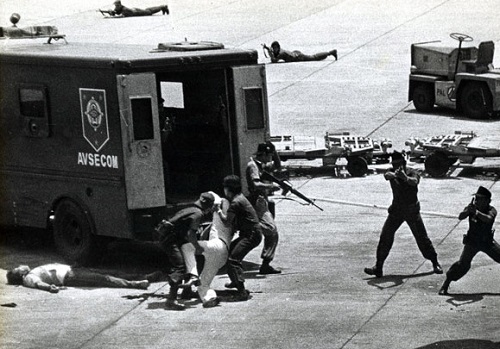Capturing Ninoy
| 20 August 2018 |

Original photograph by Times Journal photographer Recto Mercene
There are few images in Philippine history that have earned a place in the Filipino public’s collective memory. Even fewer are those that have gone on to play a part in history itself. That photo of Benigno ‘Ninoy’ Aquino’s assassination, with the ex-senator clad in white, lying lifeless on the tarmac, is definitely one of these.
Such an image wouldn’t have even seen the light of day - considering the heavy media censorship during the Martial Law period - had it not been for the tenacity of veteran photojournalist and reporter Recto Mercene, cleverly named by Esquire as “the other man who shot Ninoy”.
“I suppose I was being naive, but I was just doing my job,” said Mr. Mercene, recounting how he captured that pivotal moment from the window of a terminal bridge , ways afar from the tarmac where Mr. Aquino was gunned down.
According to Mr. Mercene, he rushed to the bridge window and started clicking away; On seeing a soldier holding a pistol and fearing he might shoot him, Mercene ducked his head down but held his camera aloft in the window, and just kept snapping pictures.
If you own a piece of history, a photo of a crucial moment - a photo that became evidence in the highly contentious commission investigations on the Sen. Aquino’s murder - how should you be credited?
In copyright law, the copyright in Mr. Mercene’s photos, taken in the course of his regular duties as a reporter for the Times Journal, belongs to his employer. As the owner of the photos, the Times Journal is vested with economic rights over them; among these being the rights to prevent the reproduction and the communication to the public of the photos.
So how did it happen that these history-making photos found themselves in every major publication for days and months following the assassination, and reprinted, and shared ad infinitum?
The Intellectual Property Office of the Philippines (IPOPHL) said there could be a caveat in the exercise of copyright over these photos. There could be a limitation on copyright IF:
“The reproduction and communication to the public of literary, scientific or artistic works as part of reports of current events by means of photography, cinematography or broadcasting to the extent necessary for the purpose.” (Intellectual Property Code of the Philippines Section 184.1 - D)
This means that when the use of the work is for the above cited purpose, there is no need even to seek the permission of the copyright owner. It would be advisable, however, to acknowledge the source of the work.
These legalities aside, the credit for these history-making pictures is of little importance to Mr. Mercene who is content on having captured, and captivated the world’s attention through his work.
“Three of my pictures were on the front page [of my newspaper], and my name right there with the big headline. We were the only ones who had those pictures, I was very happy,” Mr. Mercene said, even as the photos nearly didn’t make it to print.
According to Mr. Mercene, immediately following the assassination, he went straight to the Times Journal offices and told his editor he had photos. With permission from his editor, he quickly had them developed and made more than a dozen copies knowing full well the film roll will be taken from him by government officials.
Mr. Luis Tabuena, the Manila International Airport manager and a close associate of Mrs. Marcos, was already at the newspaper’s office when he arrived, said Mercene, but didn’t approach him. Later that day, as he predicted, the military’s media relations officer, Colonel Vicente Tigas paid the office a visit and collected the film negatives. But Mr. Mercene already had copies in hand.



